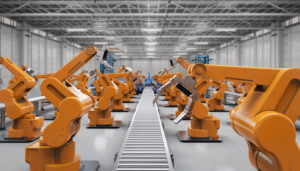Automation Survey Highlights: Now is the Time to Invest
Innovation through Automation
An industry-wide survey of its readers by Modern Materials Handling said that the modern-day warehouse is ripe for innovation, with automated distribution systems already playing a major role. According to Modern’s “Usage and Implementation of Warehouse and DC Automation Solutions” survey, companies are looking for hardware and software solutions that will either support the existing workforce or, more likely, reduce the need for human capital in the warehouse itself.

By the end of the year, the report said, the average spend on materials handling equipment and solutions will be around $1.25 million—an increase of $80,000 from 2017. And while this may seem to be an incremental rise in spend, 29 percent of people said that they would be willing to spend more than $500,000 on effective and efficient warehouse solutions.
When considering automated solutions, the key criteria were durability, reliability and uptime. A full 62 percent of people said that price was a factor, a drop of 9 percent from 12 months before. In addition, the report noted, companies are seriously considering whether investment in human capital is warranted, especially when you take into account that physical workers are becoming more difficult to recruit and retain.
Advanced Automation Is A No-Brainer
Automated systems are, according to one respondent to the Modern survey, examples of forward thinking by the warehouse industry. Robotics is still in its infancy in many organizations, with only 22 percent of people currently using industrial-scale robots for palletizing, picking or other solutions, the report said. Over the next 24 months, however, upgrades and implementation will increase to 35 percent and 46 percent, respectively.
The leap to advanced automation will rely on the level of ROI or payback that these solutions can bring to the organization. However, in many locations human capital investment—especially in sectors where robotics can be implemented with a minimum of disruption—is a decreasingly viable option which makes the decision to automate a no-brainer. Labor availability issues are quickly improving the ROI calculation for many advanced automation decisions.
Meanwhile, the availability of robotics is increasing. Global sales of industrial robots reached 380,000 units in 2017 and represented a year-on-year increase of 29 percent, according to a report by the International Federation of Robotics.
The IFR defines industrial robots as “robotic systems used for manufacturing,” which means that the global supply of automated systems is (for the moment) being dominated by sectors such as the automotive industry. And while robots that can do heavy-lifting are the norm, there is increased demand for automated systems that adapt to their environment.
“In the course of digitalization, real production is becoming increasingly connected with the virtual data world, opening up completely new possibilities for analysis—right through to machine learning,” the IFR said, in a press release. “Robots will acquire new skills through learning processes. At the same time, the industry is working to simplify the handling of robots. In the future industrial robots should be easier and faster to program using intuitive procedures.”
Berkshire Grey believes the future is already here
By taking a holistic approach to robotic automation that encompasses vision systems, advanced gripping, dynamic planning and machine learning, automation that is well suited for applications outside of manufacturing is ready now for production environments.
For more information as to how Berkshire Grey can provide robotics solutions that deliver ROI for your distribution operations, please contact us here.
Move Your Career Forward
JOIN US. We are a focused team. We bring a diverse set of experience and expertise in the fields of engineering, robotics, and artificial intelligence to building innovative yet practical and scalable solutions. Ultimately, we work at Berkshire Grey because we thrive on solving hard challenges that deliver value for our customers.
